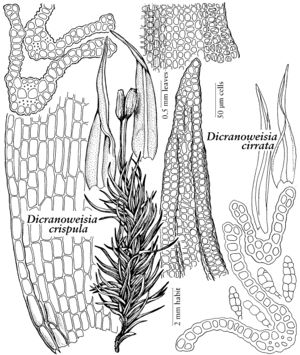Difference between revisions of "Dicranoweisia cirrata"
in C. Milde, Bryol. Siles., 49. 1869,.
Basionym: Weissia cirrata Hedwig
Treatment appears in FNA Volume 27. Treatment on page 396.
FNA>Volume Importer |
FNA>Volume Importer |
||
| Line 48: | Line 48: | ||
|publication year= | |publication year= | ||
|special status= | |special status= | ||
| − | |source xml=https://jpend@bitbucket.org/aafc-mbb/fna-data-curation.git/src/ | + | |source xml=https://jpend@bitbucket.org/aafc-mbb/fna-data-curation.git/src/8f726806613d60c220dc4493de13607dd3150896/coarse_grained_fna_xml/V27/V27_564.xml |
|genus=Dicranoweisia | |genus=Dicranoweisia | ||
|species=Dicranoweisia cirrata | |species=Dicranoweisia cirrata | ||
Revision as of 16:55, 18 September 2019
Leaves crisped and incurved when dry, margins plane to narrowly incurved or recurved at middle, 1-stratose except on margins in distal half, cells smooth; alar cells undifferentiated. Specialized asexual reproduction frequent, multicellular gemmae frequent on abaxial surface of leaves. Capsule with annulus of 1–3 rows of somewhat separating cells; peristome smooth basally, papillose distally.
Phenology: Capsules mature late fall–winter.
Habitat: Forming short turf or tufts on tree trunks and decorticated logs, rarely in rock crevices
Elevation: 1-1900 m
Distribution
B.C., Alaska, Ariz., Calif., Idaho, Mont., Oreg., Wash., Asia, n Africa.
Discussion
Selected References
None.
Lower Taxa
None.
